Research on High-Quality Development Evaluation, Space–Time Characteristics and Driving Factors of China’s Construction Industry under Carbon Emission Constraints
Abstract
:1. Introduction
2. Literature Review
2.1. Carbon Emission of Construction Industry
2.2. Construction Industry Development Evaluation
2.3. Related Research on Carbon Emission during COVID-19 Pandemic
3. Method and Index Selection
3.1. SE-SBM Model
3.2. GML Index Analysis Method
3.3. Grey Correlation Analysis
3.4. Index Selection and Data Description
4. Analysis of Spatiotemporal Heterogeneity of High-Quality Development of Construction Industry
4.1. Temporal Evolution Characteristics
- (1)
- The high-quality development level of China’s construction industry has been improved as a whole. It can be seen from Figure 2 that from 2006 to 2018, there were many provinces with poor quality of high-quality development of China’s construction industry, but by 2021, only Heilongjiang and Qinghai had poor quality of construction industry (Figure 3. shows high-quality development of China’s construction industry in 2021). The development quality of most construction industries has improved a lot, and the high-quality development with poor quality has developed to a higher level of quality. For example, Hubei and Tianjin have changed from good-quality development to better development; the quality of high-quality development in Xinjiang, Ningxia, Gansu, Yunnan and Guangxi has changed from bad quality to poor quality; the high-quality development of the construction industry in Henan and Anhui provinces had changed from poor quality to good quality. On the whole, the high-quality development level of the construction industry has significantly improved.
- (2)
- The high-quality development of the construction industry in the eastern, central and western regions is different. The comprehensive scores of the eastern region from 2006 to 2021 are greater than 1, and the development is better. The central region generally shows an upward trend, while the western region has the worst comprehensive score, and the score has a downward trend, which needs to be controlled (Figure 4 shows the comprehensive scores of high-quality development in the eastern Central western regions). Among them, we need to pay special attention to the fact that in 2013, the comprehensive score of high-quality development in the western region exceeded that in the eastern region. According to the consulting data, the reason is that the state places the focus on the development of infrastructure construction in the central and western regions as its basic position. Through data comparison, it can be seen that in 2013, although the total amount in the central region still accounted for the largest proportion, the growth rate was the smallest, while the growth rate in the western region was the fastest, among which the newly signed contract amount increased by 11.4%.
4.2. Characteristics of Spatial Pattern Evolution
4.2.1. Spatial Agglomeration Characteristics
4.2.2. Spatial Difference Characteristics
4.3. Evolution of High-Quality Development Trend of Construction Industry
5. Driving Factors for High-Quality Development of the Construction Industry
- (1)
- Urbanization level is the key factor that leads to the evolution of the space–time patterns of high-quality development evaluation of construction industry, and its correlation degree is 0.8568. The urbanization rate of China has increased from 45.2% in 2006 to 59.8% in 2021. The acceleration of the urbanization process effectively attracts the aggregation of various factors, which is conducive to the agglomeration benefits of population and industry, and the development intensity of the construction industry increases.
- (2)
- The explanatory power of carbon emission constraints is 0.8245. According to the law of “Environmental Kuznets Curve”, only on the premise of low-carbon development and improving the ability of independent innovation can we enhance the ability of sustainable development and realize the emergence of the “inflection point”. Although we need to rely on capital investment in the development of the construction industry, if we unilaterally pursue economic development and ignore the unexpected output in the process of economic development, resulting in further deterioration of the environment, we will not be able to fundamentally improve the high-quality development evaluation of the construction industry, and thus delay the emergence of the “turning point”. At the same time as promoting economic development, China has made every effort to promote ecological construction. The green coverage rate of built-up areas has increased by 4.52% in 13 years, and the forest coverage rate has reached 66.53% in 2021. The active investment in carbon emission constraints has a significant positive impact on the evaluation of high-quality development of the construction industry.
- (3)
- The explanatory power of government regulation is 0.7984. Government participation in market allocation can promote the evaluation of high-quality development of the construction industry to a certain extent. From a macro perspective, the government can formulate corresponding economic policies, participate in infrastructure construction, strengthen engineering construction control, optimize the allocation of construction resources, and scientifically manage the development of urban construction. From a micro perspective, the government can strengthen the construction of public facilities services and supporting facilities for construction land, stimulate the vitality of market players, promote more production factors into the construction industry, and improve its development efficiency.
- (4)
- The explanatory power of R & D investment is 0.7958. Investment in scientific and technological research and development can promote scientific and technological progress and innovation, effectively promote the adjustment of regional industrial structure, and promote economic growth. China’s industrial investment structure continues to be optimized, and actively promotes scientific and technological innovation to play a supporting and leading role in industrial transformation and upgrading. In 2021, the investment in high-tech industry increased by 55.62%, and its added value increased by 10.9%, an increase of 0.6 percentage points over the previous year. Moreover, scientific and technological research and development can effectively promote the adjustment of regional industrial structures, change the development mode of construction industry, improve the quality of engineering construction in the process of economic development, and promote the improvement of high-quality development evaluation.
- (5)
- The explanatory power of industrial structure upgrading is 0.7568. The pace of industrial transformation and upgrading in China has accelerated. In 2021, the three industrial structures were adjusted to 7.5:47.7:44.8, and the added value of the tertiary industry increased by 12.3%. The improvement of the industrial structure index shows that the industrial structure is optimized and upgraded to low pollution, low energy consumption, high value-added industries and resource-intensive industries, which can not only continuously improve carbon emissions, but also bring a new round of impetus to economic growth, and play a major role in promoting the high-quality development evaluation of the construction industry.
6. Conclusions
- (1)
- From the perspective of static efficiency, the overall performance of the high-quality development evaluation of the construction industry from 2006 to 2021 is sinusoidal function fluctuation, and the efficiency is in an effective state from 2012 to 2021. There are significant differences in regional efficiency, and the efficiency values of Beijing, Shanghai and Zhejiang are always at the forefront of effective technology; similar to other research results, the overall performance is that the eastern, central and western regions decrease in turn [65]. According to the evolution of spatial pattern, the regional imbalance and spatial relevance of high-quality development evaluations of the construction industry under the constraint of carbon emissions coexist, and efficient provinces are concentrated in the eastern coastal areas, forming an obvious cluster effect. However, the radiation-driving effect of high-efficiency areas is weak, and it is urgent to harness the radiation-driving ability of high-quality development of the construction industry to help regional development.
- (2)
- From the perspective of the dynamic evolution of efficiency, the total factor productivity of the construction industry showed a sinusoidal growth trend from 2006 to 2021, and the overall development trend was good. The productivity base is good, and the starting point is high. This huge base, coupled with the influence of the law of diminishing marginal productivity, causes the growth rate of total factor productivity in economically developed regions such as Beijing and Shanghai to be slower than that in economically underdeveloped regions such as Shanxi and Inner Mongolia, which give full play to their subsequent forces. According to the regional differences of GML index decomposition factors, the regional differences in technological scale changes are the largest, and are the main reason for the regional differences in total factor production growth rate; technological progress also makes a relatively large contribution to the difference in total factor growth rate. In general, technological factors are the key to reducing the difference in total factor growth rate between regions.
- (3)
- From the perspective of driving factors, urbanization level, ecological investment, government regulation, scientific and technological R & D investment and industrial structure upgrading are the main driving factors affecting the high-quality development evaluation of the construction industry. There are differences in the degree of influence of different factors, among which the level of urbanization is the most important factor. In the context of new urbanization, each region should fully consider its own development conditions, background and functional positioning, pay attention to connotative development, and comprehensively improve the high-quality development evaluation of the construction industry. This may be achieved in the following aspects: first, establish and improve the hard constraint mechanism of carbon emissions, strictly implement the negative list system of environmental access, and adhere to the path of ecological priority and green development. Second, we should actively promote the high-quality integrated development of the coordinated development zone between the East and the West and strengthen the leading role of radiation. Third, we should actively promote the healthy development of new urbanization, enhance the attractiveness and comprehensive carrying capacity of cities and towns, and further improve the socially expected output of high-quality development and utilization of the construction industry. In addition, the latest research shows that the overly competitive behavior of local governments inhibits the high-quality development of green economy [66]. Therefore, it is necessary to strengthen technical exchanges and cooperation among regions, support and encourage innovation to the maximum extent, and deeply explore the role of technological innovation factors in promoting the high-quality development evaluation of the construction industry.
Author Contributions
Funding
Institutional Review Board Statement
Informed Consent Statement
Data Availability Statement
Acknowledgments
Conflicts of Interest
References
- Sobek, W. Buildings as renewable power plants: Active houses for the electric city. Urban Energy Transit. 2018, 2, 131–138. [Google Scholar] [CrossRef]
- Zhang, L.; Balangé, L.; Braun, K.; Di Bari, R.; Horn, R.; Hos, D.; Kropp, C.; Leistner, P.; Schwieger, V. Quality as Driver for Sustainable Construction—Holistic Quality Model and Assessment. Sustainability 2020, 12, 7847. [Google Scholar] [CrossRef]
- Zhang, L.; Li, Q.; Zhou, J. Critical factors of low-carbon building development in China’s urban area. J. Clean. Prod. 2017, 142, 3075–3082. [Google Scholar] [CrossRef]
- Zhang, K.; Lu, Y.; Lu, H. Research on high quality development countermeasures of green buildings in China under the background of double carbon goals. Constr. Econ. 2022, 43, 14–20. [Google Scholar] [CrossRef]
- Zhang, J.; Hou, Y.; Liu, P.; He, J.; Zhuo, X. Objective requirements and strategic path of high-quality development. J. Manag. World 2019, 35, 1–7. [Google Scholar] [CrossRef]
- Sun, J.; Zheng, M.; Fu, J. Connotation and Policy Suggestions of High-quality Development of Construction Industry in New Era. Constr. Econ. 2019, 40, 5–9. [Google Scholar] [CrossRef]
- Wang, Y.; Shi, H.; Yan, H.; Huang, W.; Hao, Z. Analysis of carbon emission intensity distribution and spatial effect of China’s construction industry based on SDM. J. Eng. Manag. 2021, 35, 1–6. [Google Scholar] [CrossRef]
- Zhang, Y. Research on Efficiency Evaluation of China’s Construction Industry from the Perspective of Low Carbon. Master’s Thesis, Hebei University of Economics and Trade, Shijiazhuang, China, 2022. [Google Scholar] [CrossRef]
- Liu, H. Research on the Impact Mechanism of Emission Reduction Effect of China’s Construction Carbon Emission Trading. Master’s Thesis, China University of Mining and Technology, Beijing, China, 2021. [Google Scholar] [CrossRef]
- Li, F. Research on Regional Differences and Influencing Factors of Carbon Dioxide Emissions from China’s Construction Industry. Master’s Thesis, Fujian Normal University, Fuzhou, China, 2020. [Google Scholar] [CrossRef]
- Zheng, C. Analysis on the Spatial Effect and Driving Factors of Carbon Emissions in China’s Construction Industry. Master’s Thesis, Harbin Institute of Technology, Harbin, China, 2020. [Google Scholar] [CrossRef]
- An, L. Research on the Influencing Factors of Carbon Emissions from Construction Industry in Liaoning Province Based on LMDI. Master’s Thesis, Shenyang Architecture University, Shenyang, China, 2020. [Google Scholar] [CrossRef]
- Wang, J.; Wei, J. Change characteristics and scenario simulation of carbon emissions from building operation in Beijing under time series. J. Beijing Univ. Technol. 2022, 48, 220–229. [Google Scholar] [CrossRef]
- Rinne, R.; Ilgın, H.E.; Karjalainen, M. Comparative Study on Life-Cycle Assessment and Carbon Footprint of Hybrid, Concrete and Timber Apartment Buildings in Finland. Int. Environ. Res. Public Health 2022, 19, 774. [Google Scholar] [CrossRef]
- Han, Q.; Chang, J.; Liu, G.; Zhang, H. The Carbon Emission Assessment of a Building with Different Prefabrication Rates in the Construction Stage. Int. Environ. Res. Public Health 2022, 19, 2366. [Google Scholar] [CrossRef]
- Zheng, Y.; Ou, J.; Chen, G.; Wu, X.; Liu, X. Mapping Building-Based Spatiotemporal Distributions of Carbon Dioxide Emission: A Case Study in England. Int. Environ. Res. Public Health 2022, 19, 5986. [Google Scholar] [CrossRef]
- Erdogan, S. Dynamic nexus between technological innovation and buildings Sector’s carbon emission in BRICS countries. J. Environ. Manag. 2021, 293, 112780. [Google Scholar] [CrossRef]
- Liu, Z. Research on the Regional Effect of Carbon Emissions from China’s Construction Industry from the Perspective of Urbanization. Master’s Thesis, Jiangsu University of Science and Technology, Zhenjiang, China, 2020. [Google Scholar] [CrossRef]
- Jiang, B.; Huang, B.; Zhang, H. Research on the influencing factors of carbon emissions from construction industry in Jiangsu Province Based on LMDI model. Environ. Sci. Technol. 2021, 44, 202–212. [Google Scholar] [CrossRef]
- Li, D.; Huang, G.; Zhang, G.; Wang, J. Driving factors of total carbon emissions from the construction industry in Jiangsu Province, China. J. Clean. Prod. 2020, 276, 123179. [Google Scholar] [CrossRef]
- Lu, N.; Feng, S.; Liu, Z.; Wang, W.; Lu, H.; Wang, M. The Determinants of Carbon Emissions in the Chinese Construction Industry: A Spatial Analysis. Sustainability 2020, 12, 1428. [Google Scholar] [CrossRef]
- Zhou, Y.; Liu, W.; Lv, X.; Chen, X.; Shen, M. Investigating interior driving factors and cross-industrial linkages of carbon emission efficiency in China’s construction industry: Based on Super-SBM DEA and GVAR model. J. Clean. Prod. 2019, 241, 118322. [Google Scholar] [CrossRef]
- He, J.; Yue, Q.; Li, Y.; Zhao, F.; Wang, H. Driving force analysis of carbon emissions in China’s building industry: 2000–2015. Sustain. Cities Soc. 2020, 60, 102268. [Google Scholar] [CrossRef]
- Shi, Q.; Chen, J.; Shen, L. Driving factors of the changes in the carbon emissions in the Chinese construction industry. J. Clean. Prod. 2017, 166, 615–627. [Google Scholar] [CrossRef]
- Wang, Y. Research on Temporal and Spatial Differences and Influencing Factors of Carbon Emission Intensity in China’s Construction Industry. Master’s Thesis, Harbin Normal University, Harbin, China, 2021. [Google Scholar] [CrossRef]
- Li, B. Factor Decomposition and Peak Prediction of Carbon Emissions from China’s Construction Industry. Master’s Thesis, Northeast University of Finance and Economics, Dalian, China, 2020. [Google Scholar] [CrossRef]
- Du, Q.; Yan, Y.; Huang, Y.; Hao, C.; Wu, J. Evolutionary Games of Low-Carbon Behaviors of Construction Stakeholders under Carbon Taxes. Int. Environ. Res. Public Health 2021, 18, 508. [Google Scholar] [CrossRef]
- Hong, J.; Li, Y.; Guo, L. Simulation of building carbon emission path from the perspective of the whole industry chain: Based on rice-leap model. China Environ. Sci. 2022, 1, 1–11. [Google Scholar] [CrossRef]
- Du, Q.; Shao, L.; Zhou, J.; Huang, N.; Bao, T.; Hao, C. Dynamics and scenarios of carbon emissions in China’s construction industry. Sustain. Cities Soc. 2019, 48, 101556. [Google Scholar] [CrossRef]
- Zhang, P.; Hu, J.; Zhao, K.; Chen, H.; Zhao, S.; Li, W. Dynamics and Decoupling Analysis of Carbon Emissions from Construction Industry in China. Buildings 2022, 12, 257. [Google Scholar] [CrossRef]
- Du, Q.; Zhou, J.; Pan, T.; Sun, Q.; Wu, M. Relationship of carbon emissions and economic growth in China’s construction industry. J. Clean. Prod. 2019, 220, 99–109. [Google Scholar] [CrossRef]
- Wang, Z.; Zhou, Y.; Zhao, N.; Wang, T.; Zhang, Z. Spatial Correlation Network and Driving Effect of Carbon Emission Intensity in China’s Construction Industry. Buildings 2022, 12, 201. [Google Scholar] [CrossRef]
- Li, D.; Huang, G.; Zhu, S.; Chen, L.; Wang, J. How to peak carbon emissions of provincial construction industry? Scenario analysis of Jiangsu Province. Renew. Sustain. Energy Rev. 2021, 144, 110953. [Google Scholar] [CrossRef]
- Li, B.; Han, S.; Wang, Y.; Li, J.; Wang, Y. Feasibility assessment of the carbon emissions peak in China’s construction industry: Factor decomposition and peak forecast. Sci. Total Environ. 2019, 706, 135716. [Google Scholar] [CrossRef]
- Lu, W.; Tam, V.W.; Chen, H.; Du, L. A holistic review of research on carbon emissions of green building construction industry. Eng. Constr. Archit. Manag. 2020, 27, 1065–1092. [Google Scholar] [CrossRef]
- Roh, S.; Tae, S.; Kim, R. Developing a Green Building Index (GBI) Certification System to Effectively Reduce Carbon Emissions in South Korea’s Building Industry. Sustainability 2018, 10, 1872. [Google Scholar] [CrossRef]
- Du, Q.; Lu, X.; Li, Y.; Wu, M.; Bai, L.; Yu, M. Carbon Emissions in China’s Construction Industry: Calculations, Factors and Regions. Int. J. Environ. Res. Public Health 2018, 15, 1220. [Google Scholar] [CrossRef]
- Luo, C. Research on the Spatial Difference of Efficiency in China’s Construction Industry Based on DEA Model. Master’s Thesis, Xihua University, Chengdu, China, 2020. [Google Scholar] [CrossRef]
- Yin, T. Research on the Spatial Spillover Effect of Green Total Factor Productivity in China’s Provincial Construction Industry. Master’s Thesis, Anhui Jianzhu University, Hefei, China, 2021. [Google Scholar] [CrossRef]
- Peng, X. Research on the Spatial Distribution and Influencing Factors of Green Total Factor Productivity in China’s Construction Industry. Master’s Thesis, Chang’an University, Xi’an, China, 2021. [Google Scholar] [CrossRef]
- Wang, Y. Research on the Space-Time Characteristics and Influencing Factors of High-Quality Development of China’s Construction Industry. Master’s Thesis, Anhui University of Architecture, Hefei, China, 2020. [Google Scholar] [CrossRef]
- Wang, Y. Research on Post Occupancy Evaluation Method and Application for Primary School Children. Master’s Thesis, South China University of Technnology, Guangzhou, China, 2019. [Google Scholar] [CrossRef]
- Shao, S.; Wang, C.; Feng, K.; Guo, Y.; Feng, F.; Shan, Y.; Meng, J.; Chen, S. How do China’s lockdown and post-COVID-19 stimuli impact carbon emissions and economic output? Retrospective estimates and prospective trajectories. iScience 2022, 25, 104328. [Google Scholar] [CrossRef]
- Zhang, X.; Li, Z.; Wang, J. Impact of COVID-19 pandemic on energy consumption and carbon dioxide emissions in China’s transportation sector. Case Stud. Therm. Eng. 2021, 26, 101091. [Google Scholar] [CrossRef]
- Tian, Y.; Li, L. Will COVID-19 affect China’s peak CO2 emissions in 2030? An analysis based on the systems dynamics model of green finance. J. Clean. Prod. 2022, 356, 131777. [Google Scholar] [CrossRef]
- Yang, Y.; Zhao, L.; Xie, Y.; Wang, C.; Xue, J. China’s COVID-19 lockdown challenges the ultralow emission policy. Atmos. Pollut. Res. 2020, 12, 395–403. [Google Scholar] [CrossRef]
- Wang, Q.; Li, S.; Li, R.; Jiang, F. Underestimated impact of the COVID-19 on carbon emission reduction in developing countries—A novel assessment based on scenario analysis. Environ. Res. 2021, 204 Pt A, 111990. [Google Scholar] [CrossRef]
- Wang, Q.; Wang, S. Preventing carbon emission retaliatory rebound post-COVID-19 requires expanding free trade and improving energy efficiency. Sci. Total Environ. 2020, 746, 141158. [Google Scholar] [CrossRef] [PubMed]
- Wang, Q.; Li, S.; Jiang, F. Uncovering the impact of the COVID-19 pandemic on energy consumption: New insight from difference between pandemic-free scenario and actual electricity consumption in China. J. Clean. Prod. 2021, 313, 127897. [Google Scholar] [CrossRef]
- Han, P.; Cai, Q.; Oda, T.; Zeng, N.; Shan, Y.; Lin, X.; Liu, D. Assessing the recent impact of COVID-19 on carbon emissions from China using domestic economic data. Sci. Total Environ. 2020, 750, 141688. [Google Scholar] [CrossRef]
- Ray, R.L.; Singh, V.P.; Singh, S.K.; Acharya, B.S.; He, Y. What is the impact of COVID-19 pandemic on global carbon emissions? Sci. Total Environ. 2021, 816, 151503. [Google Scholar] [CrossRef]
- Chong, C.T.; Van Fan, Y.; Lee, C.T.; Klemeš, J.J. Post COVID-19 ENERGY sustainability and carbon emissions neutrality. Energy 2021, 241, 122801. [Google Scholar] [CrossRef]
- Li, K.; Qi, S.; Shi, X. The COVID-19 pandemic and energy transitions: Evidence from low-carbon power generation in China. J. Clean. Prod. 2022, 368, 132994. [Google Scholar] [CrossRef]
- Zhang, L.; Chen, M.; Xu, Q.; Zhang, J. Ranking of decision-making units considering unexpected factors: Two-stage comprehensive efficiency method. Oper. Res. Manag. 2021, 30, 57–63. [Google Scholar] [CrossRef]
- Qin, X.; Wang, J. Improvement and application of Malmquist Luenberger index without feasible solution—Taking the production efficiency evaluation of commercial banks as an example. Syst. Eng. 2022, 40, 33–44. [Google Scholar]
- Niu, J.; Xie, T.; Guo, Y.; Sun, Z. Estimation of Tobit regression model when covariates have measurement errors. Syst. Sci. Math. 2020, 40, 1672–1686. [Google Scholar] [CrossRef]
- Tone, K. A slacks-based measure of efficiency in data envelopment analysis. Eur. J. Oper. Res. 2001, 130, 498–509. [Google Scholar] [CrossRef]
- Tone, K. A slacks-based measure of super-efficiency in data envelopment analysis. Eur. J. Oper. Res. 2002, 143, 32–41. [Google Scholar] [CrossRef]
- Han, Z.; Xia, K.; Guo, J.; Sun, C.; Deng, Z. Based on the global Malmquist Luenberger index, the level of land and sea integrated development in coastal areas is measured and regional differences are analyzed. J. Nat. Resour. 2017, 32, 1271–1285. [Google Scholar] [CrossRef]
- Oh, D. A global Malmquist-Luenberger productivity index. J. Product. Anal. 2010, 34, 183–197. [Google Scholar] [CrossRef]
- Grifell-Tatjé, E.; Lovell, C.A.K. A generalized Malmquist productivity index. Top 1999, 7, 81–101. [Google Scholar] [CrossRef]
- Färe, R.; Grosskopf, S.; Norris, M.; Zhang, Z. Productivity growth, technical progress, and efficiency change in industrialized countries. Am. Econ. Rev. 1994, 84, 66–83. [Google Scholar] [CrossRef]
- Feng, B.; Wang, X. Research on decoupling and influencing factors of carbon emissions from construction industry in China. China population. Resour. Environ. 2015, 25, 28–34. [Google Scholar] [CrossRef]
- Gao, Y.; Yang, G.; Xie, Q. Spatial-Temporal Evolution and Driving Factors of Green Building Development in China. Sustainability 2020, 12, 2773. [Google Scholar] [CrossRef]
- Xu, S.; Ma, C.; Zhang, S.; Yuan, B. Measurement and influencing factors of eco-economic efficiency of China’s construction industry. Environ. Pollut. Control 2022, 44, 833–840. [Google Scholar] [CrossRef]
- Wei, D.; Gu, N.; Liu, Y. Haze Governance, local Government Behavior and High-quality Development of Green Economy: Evidence from Chinese Counties. Econ. Sci. 2022, 44, 64–77. [Google Scholar] [CrossRef]
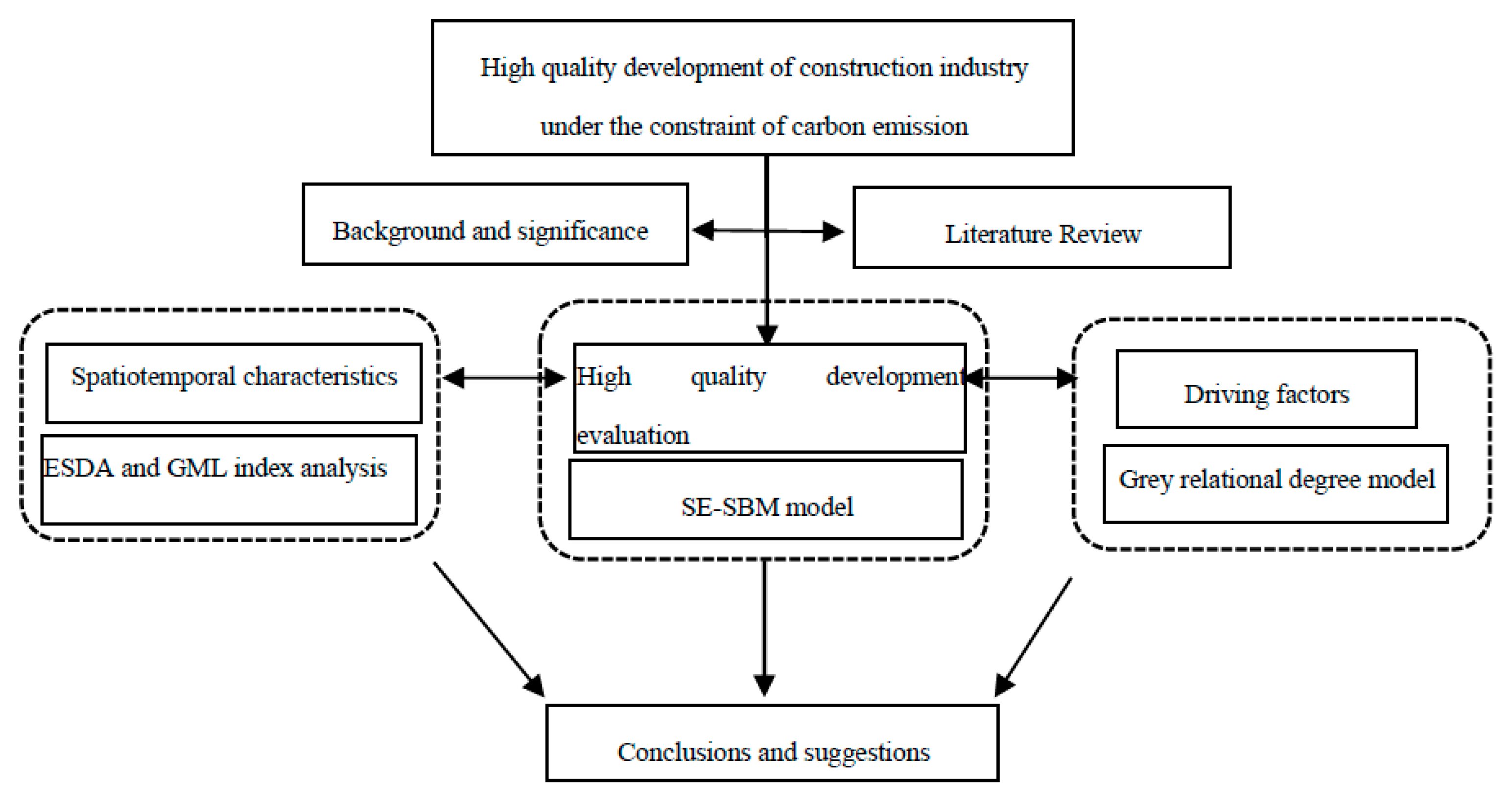
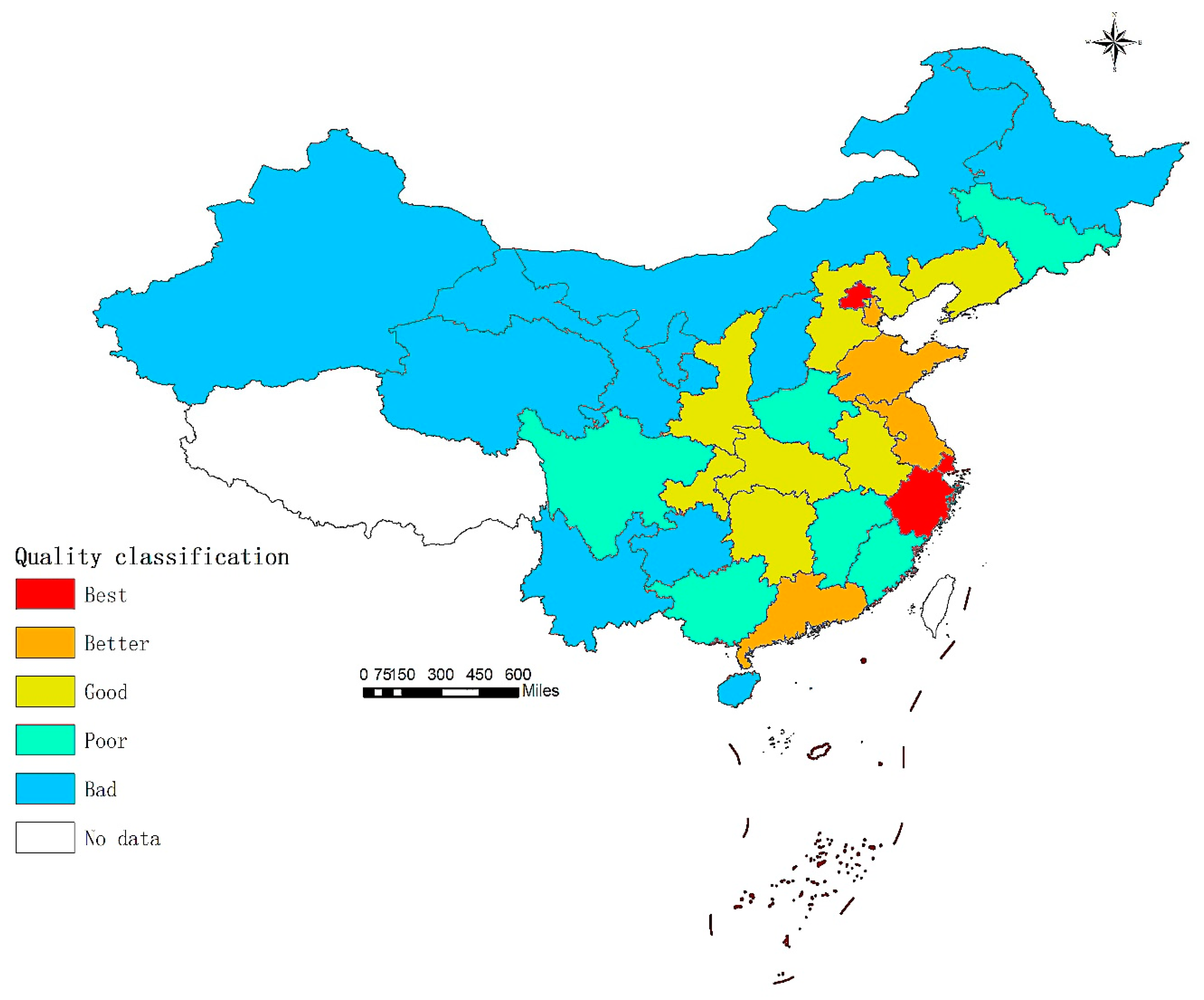
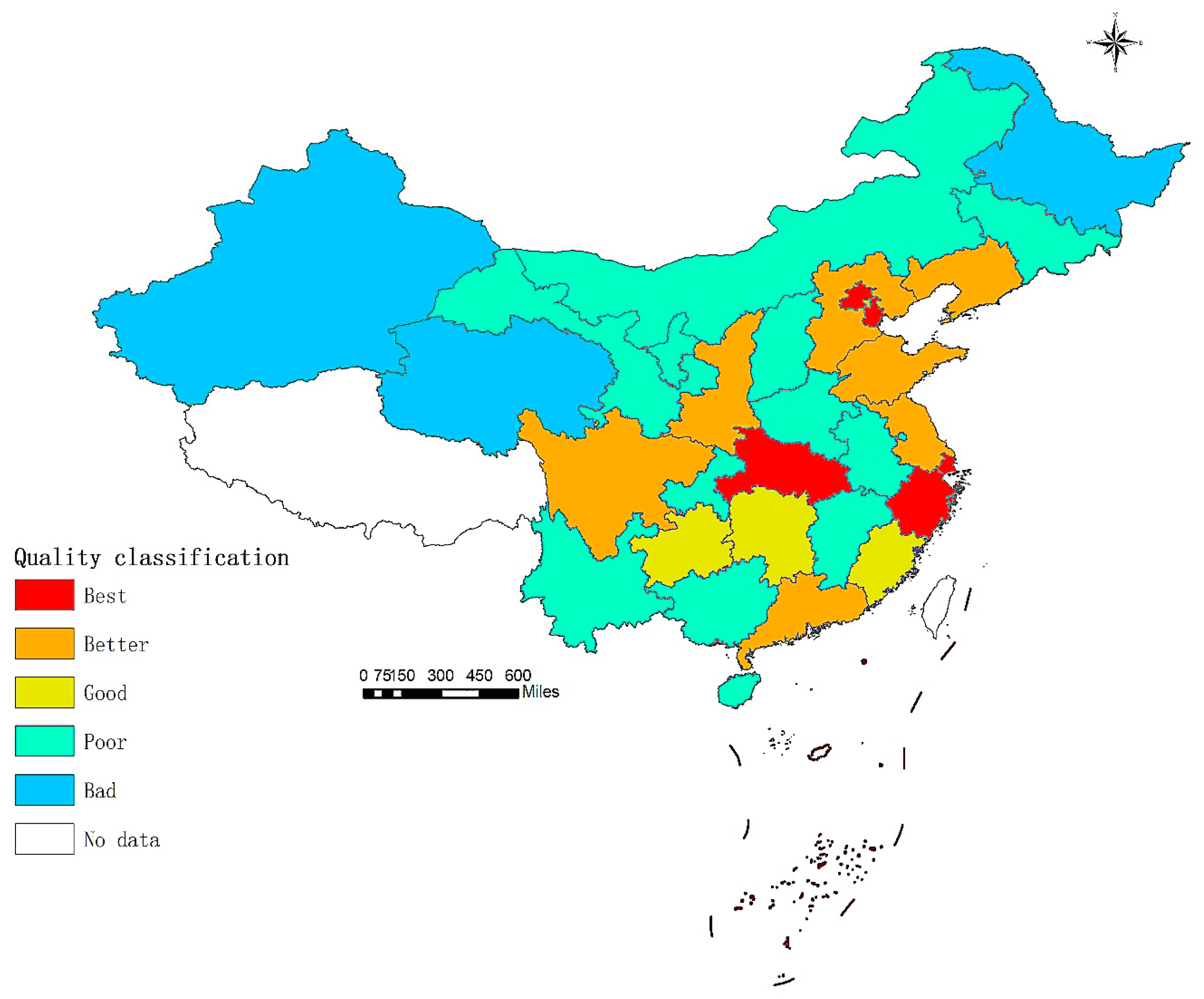
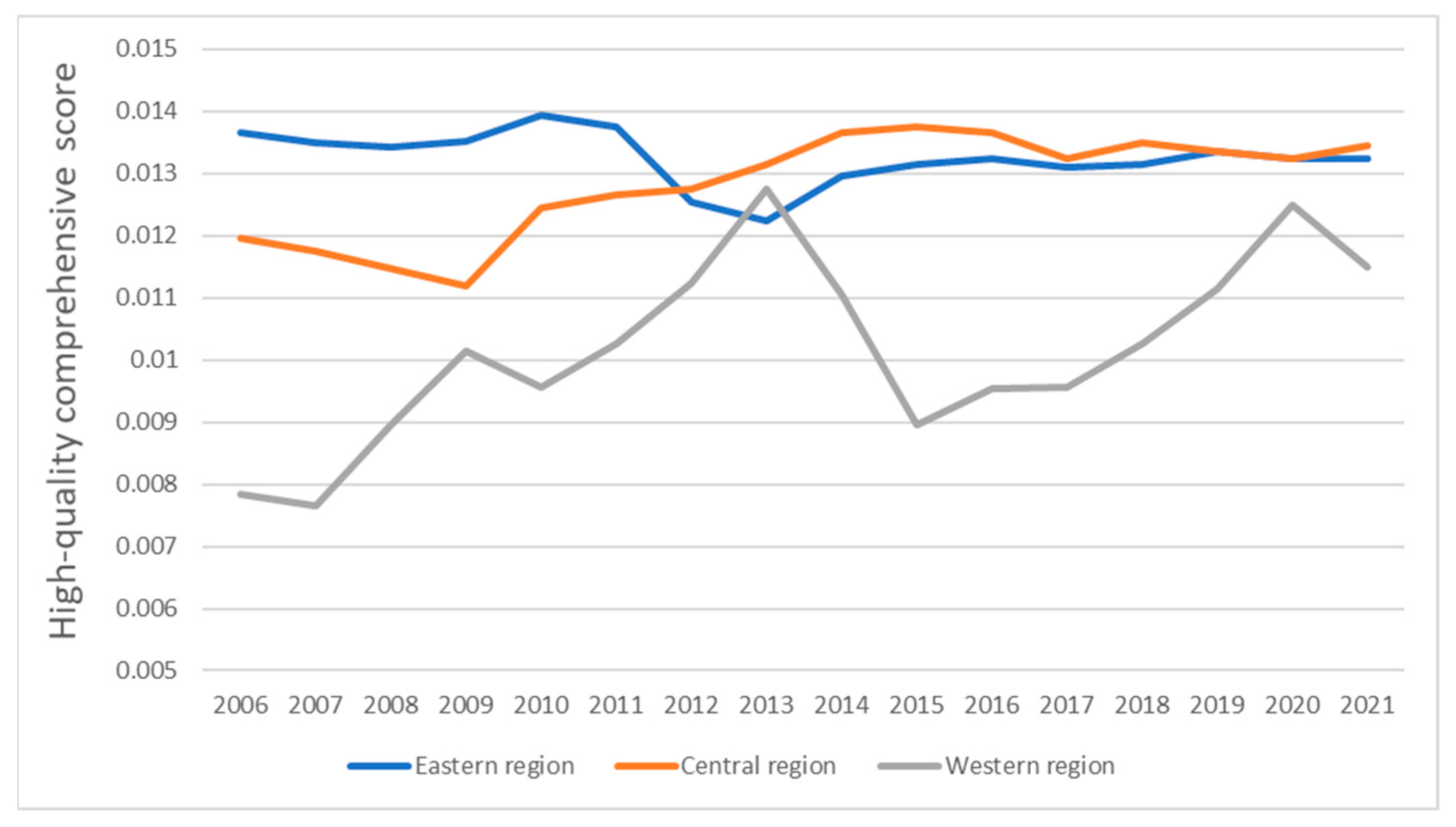
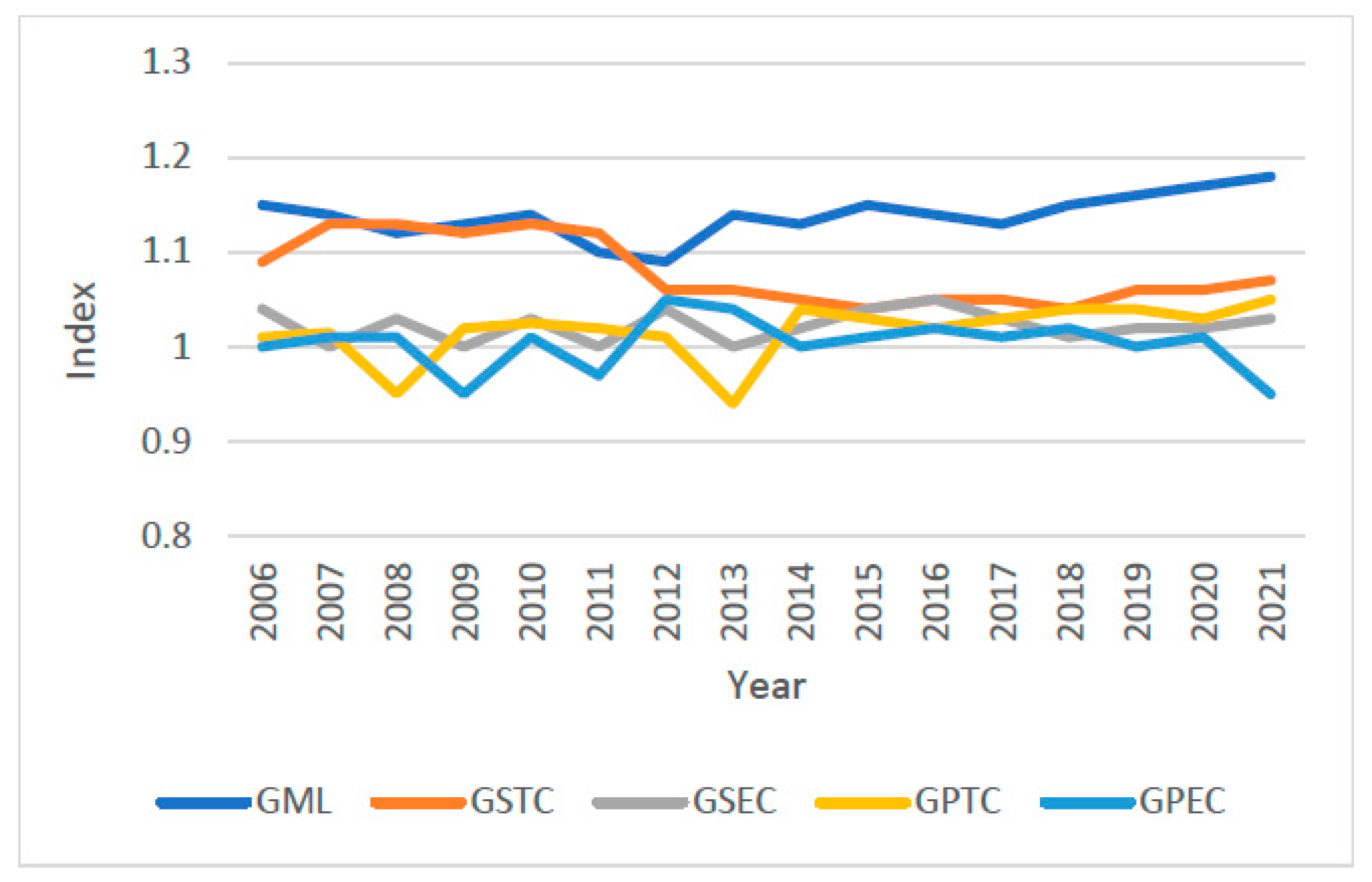
| Energy | Average Low Calorific Value (kJ/kg or kJ/m3) | Carbon Content Per Calorific Value (t-C/TJ) | Carbon Oxidation Rate |
|---|---|---|---|
| Raw coal | 20,980 | 26.37 | 0.94 |
| Briquette coal | 15,910 | 33.56 | 0.90 |
| Carbon coke | 28,435 | 29.42 | 0.93 |
| Coal oil | 43,070 | 19.60 | 0.98 |
| Diesel fuel | 42,652 | 20.20 | 0.98 |
| Fuel oil | 41,816 | 21.10 | 0.98 |
| Liquefied petroleum gas | 50,179 | 17.20 | 0.98 |
| Natural gas | 38,931 | 15.32 | 0.99 |
| Regional Grid | Carbon Emission Factor (tCO2/MWh) |
|---|---|
| North China Regional power grid | 0.9680 |
| Northeast China Regional power grid | 1.1082 |
| East China Regional power grid | 0.8046 |
| Central China Regional power grid | 0.9014 |
| Northwest China Regional power grid | 0.9511 |
| South China Regional power grid | 0.8367 |
| Region | Efficiency | Region | Efficiency | ||
|---|---|---|---|---|---|
| 2006–2018 | 2019–2021 | 2006–2018 | 2019–2021 | ||
| Beijing | 2.845 | 2.209 | Anhui | 0.854 | 0.942 |
| Shanghai | 2.421 | 2.097 | Hainan | 0.853 | 0.895 |
| Zhejiang | 2.058 | 2.124 | Chongqing | 0.79 | 0.862 |
| Hubei | 1.863 | 2.012 | Henan | 0.786 | 0.852 |
| Tianjin | 1.801 | 2.014 | Jiangxi | 0.699 | 0.863 |
| Jiangsu | 1.601 | 1.850 | Neimenggu | 0.407 | 0.862 |
| Guangdong | 1.324 | 1.847 | Jilin | 0.502 | 0.841 |
| Hebei | 1.244 | 1.652 | Yunnan | 0.494 | 0.821 |
| Shanxi | 1.171 | 1.511 | Xinjiang | 0.482 | 0.465 |
| Hunan | 1.047 | 1.425 | Guangxi | 0.456 | 0.721 |
| Shandong | 1.016 | 1.515 | Ningxia | 0.421 | 0.685 |
| Guizhou | 0.978 | 1.013 | Shanxi | 0.325 | 0.562 |
| Fujian | 0.888 | 1.012 | Gansu | 0.251 | 0.553 |
| Liaoning | 0.877 | 0.855 | Heilongjiang | 0.066 | 0.241 |
| Sichuan | 0.859 | 1.854 | Qinghai | 0.047 | 0.224 |
| Building Materials | Carbon Emission Factor (kg/kg or kg/m3) | Recovery Factor |
|---|---|---|
| Steel | 1.789 | 0.8 |
| Wood | −842.8 | - |
| Cement | 0.815 | - |
| Glass | 0.966 | - |
| Aluninum | 2.6 | 0.85 |
| Influence Factor | Variable Description | Grey Correlation Degree | Association Level |
|---|---|---|---|
| Economic development level | Variable description | 0.5375 | moderate |
| Advanced industrial structure | Per capita GDP/10,000 yuan | 0.7568 | strong |
| Government regulation | Industrial structure upgrading index | 0.7984 | strong |
| Urbanization level | Proportion of government expenditure in regional GDP/% | 0.8568 | strong |
| Human–land relationship | Proportion of urban population/% | 0.5902 | moderate |
| Investment intensity of construction industry | Population density | 0.7159 | strong |
| External dependence | Proportion of total import and export value in GDP/% | 0.5874 | moderate |
| Investment in scientific and technological research and development | Proportion of science and technology investment in GDP/% | 0.7958 | strong |
| Ecological input | Greening coverage rate/% | 0.8245 | strong |
Publisher’s Note: MDPI stays neutral with regard to jurisdictional claims in published maps and institutional affiliations. |
© 2022 by the authors. Licensee MDPI, Basel, Switzerland. This article is an open access article distributed under the terms and conditions of the Creative Commons Attribution (CC BY) license (https://creativecommons.org/licenses/by/4.0/).
Share and Cite
Wang, Y.; Wu, X. Research on High-Quality Development Evaluation, Space–Time Characteristics and Driving Factors of China’s Construction Industry under Carbon Emission Constraints. Sustainability 2022, 14, 10729. https://doi.org/10.3390/su141710729
Wang Y, Wu X. Research on High-Quality Development Evaluation, Space–Time Characteristics and Driving Factors of China’s Construction Industry under Carbon Emission Constraints. Sustainability. 2022; 14(17):10729. https://doi.org/10.3390/su141710729
Chicago/Turabian StyleWang, Yan, and Xi Wu. 2022. "Research on High-Quality Development Evaluation, Space–Time Characteristics and Driving Factors of China’s Construction Industry under Carbon Emission Constraints" Sustainability 14, no. 17: 10729. https://doi.org/10.3390/su141710729
APA StyleWang, Y., & Wu, X. (2022). Research on High-Quality Development Evaluation, Space–Time Characteristics and Driving Factors of China’s Construction Industry under Carbon Emission Constraints. Sustainability, 14(17), 10729. https://doi.org/10.3390/su141710729





